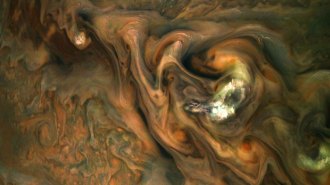Search Results
Too hot to handle
Heat waves are becoming more frequent around the globe, and scientists are studying humans’ ability to endure the extra heat. Get students thinking about what it means to handle heat and explore basic thermodynamic concepts through diagramming. Learning Outcomes: Diagramming
Exploring materials
After reading a journalistic article about materials science and engineering over the last century, students will discuss and research why and how new materials are developed and how they transform society. Student groups will develop museum-style exhibits to communicate what they learned to the rest of the class.
Century of Science scavenger hunt
Students will use the clues provided and the Science News Century of Science website to explore how science advances. After making connections across scientific subtopics, student groups will research and present highlights of discoveries from an assigned decade.
The physics of flying seeds
Students will design and build models inspired by flying seeds with the goal of making the models travel as far as possible. Students will test the models, analyze which ones performed the best and explain why those models performed well using physics principles.

Camera Captures Physics in a Snap
In this guide, students will learn about an experiment inspired by the movie Avengers: Infinity War that investigates the role of friction in a successful finger snap. Students will then apply their scientific knowledge to assess scientific accuracy in movies and other media.
Science in a snap
Students will answer questions about the online Science News article “New high-speed video reveals the physics of a finger snap,” which details scientists’ exploration of the friction required for finger snapping. A version of the article, “Camera captures physics in a snap,” appears in the December 18, 2021 & January 1, 2022 issue of Science News.
Science on screen
Students will discuss the physics of finger snapping and apply their scientific knowledge to think critically about the scientific accuracy of movies and online demonstrations.
How ducklings dodge drag
Students will discuss the physics of drag using real-world examples.
Quacking the physics of duckling swimming
Students will answer questions about the online Science News article “Here’s the physics of why ducklings swim in a row behind their mother,” which details how baby ducks save energy by surfing their mom’s waves. A version of the article, “Why baby ducks swim in a line,” appears in the November 20, 2021 issue of Science News.
Reimagining plastics recycling
Students will evaluate experimental methods for recycling plastics, gather data about the types of plastics they use at home, research plastics recycling in their community and write a letter to local officials that advocates for improving plastics recycling.
Dig into atomic models
Students will research how knowledge of the atom has changed over time, visually represent a historic atomic model and present that model to the class. Students can also explore the standard model of particle physics and discuss ways it could be depicted.

Physics Helps Alien Rain Stay In Shape
In this guide, students will learn how the laws of physics shape rain on other planets and explore how molecules interact within alien raindrops.